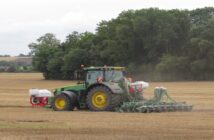According to the Met office, May this year was the coldest May since 1996. It has been very unsettled and unseasonably cold. The provisional mean temperature in May was 9.1°C which is 1.3°C below the 1981-2010 long term average. We asked two specialist agronomists and a crop protection manufacturer about the impact of the cold weather.
Phillippa Dodds, Head of Agronomy for Angus Growers, works in partnership with their marketing agent Angus Soft Fruits who breed, grow and pack berries for UK and European retailers. She remarks that in Scotland it has been a slower start to the season because of the cold spell and frosts close to the start of flowering. Meteorological data shows that Scotland’s provisional mean temperature in May was 7.6°C which is 0.7°C below the 1981-2010 long term average. “I would say that production of strawberries in Scotland was initially between 1 to 2 weeks behind. But with the recent welcome sunshine, crops are starting to get going and are catching up. Good growing conditions now mean crops are ripening at a good speed and giving us good quality produce.”
“In terms of disease pressure, we have to be vigilant of Botrytis when it is cool and wet. Now temperatures are recovering, it is powdery mildew to look out for. We would control these two diseases in strawberries using an integrated programme of both conventional and biological products with different modes of action which is tailored to the weather. We would try to minimise the number of sprays as much as possible,” she says.
Powdery mildew is caused by the fungus Podosphaera apanis and in the UK is the most important disease of fruit crops grown under protection, especially the long season or late season ones. The fungus can attack all above the ground parts of the plant. In severe infections it can reduce both yield and quality. It thrives in warm humid conditions with most strawberry cultivars being very susceptible.
Last year BASF launched a biological fungicide, Serifel. Matthew Goodson of BASF explains that it is based on Bacillus amyloliquefaciens strain MB1600 and is a protectant fungicide for the reduction of Botrytis on most protected fruits including strawberries. “It can be integrated into a programme with Charm (fluxapyroxad) in strawberries when in addition to controlling botrytis, we have found it also offers useful powdery mildew control. Serifel has a nil day harvest interval, so is positioned at the end of the programme onto mature fruit and can be used up to 6 times. It has multiple modes of action, so its risk of resistance is very low. Charm can be used 3 times, has a 1-day harvest interval in strawberries and it is often positioned at the beginning of the programme. Serifel brings flexibility and choice to a programme and the results of some recent work on an integrated programme using Charm early in a programme on 14-day intervals followed by 3 applications of Serifel on 7-day intervals showed excellent performance when controlling powdery mildew compared with many other programmes. The strain MB1600 was isolated in the UK, and it appears to be well adapted to the UK’s fickle climate.”
Matthew reports that Charm moves to new growth and has rapid uptake, mobility, and persistence. Serifel on the other hand works as a preventative. “Together with Serifel we have shown outstanding control of powdery mildew in strawberries, raising the bar of disease control levels. In my view integration of chemical and biologicals has to be the way forward in the speciality crop sector.”
Phillippa Dodds is on board with this approach integrating conventional products with biologicals in strawberries and other soft fruits, “Raspberries have also had a slow start this year but are now getting going with good speed of ripening, so we may well see a more condensed picking period in some crops. The sunshine we are seeing now is good for producing flavour which is what the consumer wants.”
Advising soft fruit growers in Kent, Hampshire, Surrey, and Berkshire for Agrovista, agronomist Simon Warren comments that the early season was cold in the Southeast and early planted crops were slowed down by this cooler weather. “I would say crops are 2 weeks behind where we were last year. The worry is that we may have a lot of fruit coming at the same time. This applies to strawberries, as well as raspberries.”
Simon says that the crops look good now, and he expects a good quality crop. “Many strawberries are large size, as are raspberries and blueberries. With the warmer weather, I would be expecting to see more pest such as aphids, thrips, and spider mites. I am only just seeing powdery mildew on plants for the first time this season. Overall, I think we will get the quantity and quality of soft fruit crops but what is worrying is that they may all come together, having an impact on pricing for the grower. If this is the case, the fruit must look top quality and be free of pests and diseases and they must look blemish-free.”




